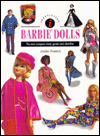Identifying Barbie Dolls. Janine Fennick. 1998. 80 pages. [Source: Bought]
First sentence: Collecting Barbie dolls is one of the most popular hobbies today.
Premise/plot: Janine Fennick's book is a nonfiction guide for adults (primarily) about collecting Barbie dolls and caring for your doll collection. She essentially divides Barbie dolls into three categories. (The book was published in 1998; I'd argue there needs to be a fourth category). Her categories are: "The Ponytail Era" (1959-1966), "The Mod Era" (1967-1972), and "The Collectible Era" (1973-present).
The first fifteen pages essentially act as an introduction to doll collecting itself. The remaining three chapters focus on a specific era of doll production.
The writing is both technical and practical. A fun, swinging narrative it is not. If you want to know the difference between a #1 Ponytail and a #2 Ponytail (the first two dolls) this book will tell you ALL you need to know. If you want to know what year Midge got bendable legs, this book is for you.
My thoughts: I'll be honest, though she discusses all three eras, the author's bias for the first two eras is obvious. I wouldn't mind knowing what she thinks of the current state of Barbie. (I am disappointed not with the Fashionista line, but, with the other offerings. Almost all Barbies produced in the past five to seven years have the exact same face, almost the exact same makeup, almost the exact same hair. There is no point anymore to buying *more* dolls. To have two or three dolls with the same face is one thing. Twins! Triplets! But to have sixteen? That's just CREEPY. Instead of buying more dolls, you'd almost be better off just buying fashion accessories. But clothes can be very taste specific. (I always LOVED, LOVED, LOVED sewing my own Barbie clothes. In fact it's probably the number one thing I miss about playing with Barbies.) I miss the 80s and 90s. Yes, the author doesn't really see the point of it all. But I did and do.
Probably the biggest strength of this book is the use of COLOR photographs. So many dolls, so many fashions shared in FULL color. Some of the Barbie biographies (for lack of a better word) just have black and white photographs. Yes, the narrative might be more entertaining. But it's the PICTURES OF BARBIE that makes you want to keep flipping through the pages.
I should also note that I am and always will be a believer that Barbie is meant to be played with and loved. This view puts me at slight odds with the strict collector looking for everything to be in a never been opened box.
© 2016 Becky Laney of Becky's Book Reviews


3 comments:
Not surprisingly, I also loved sewing Barbie clothes. My cousin was older, so she had an original doll, and I loved looking at the clothing catalogs she had for her! Haven't thought of Barbies in years-- my daughters had no interest in them whatsoever!
I miss the 80s and 90s too. My sister and I were big fans of Barbies. We loved creating personalities for them and playing out dramatic storylines. (We were not as into the fashion.) Sadly, I don't think my daughters will have Barbies. The newer ones are just not the same.
For me it was definitely both. I loved playing with the dolls. Most were fully developed characters with likes, dislikes, strong opinions, and unique style. To this day my sister and I can see something or hear something and go, "That's so Scarlett, or that's so Carrie."
The 80s and 90s were the best. I think the somewhat recent decision to make every single Barbie doll have the exact same face was a huge, huge mistake. Why would you ever need more than one--or two?! And what's the fun of playing Barbies if you just have one or two?! And store-bought clothes are so expensive it's ridiculous. (Hence why I made my own clothes for them. I had about four or five patterns from the late 70s to early 80s. And occasionally--I'd buy new patterns. I think by the end, I had about ten or twelve patterns.)
Post a Comment